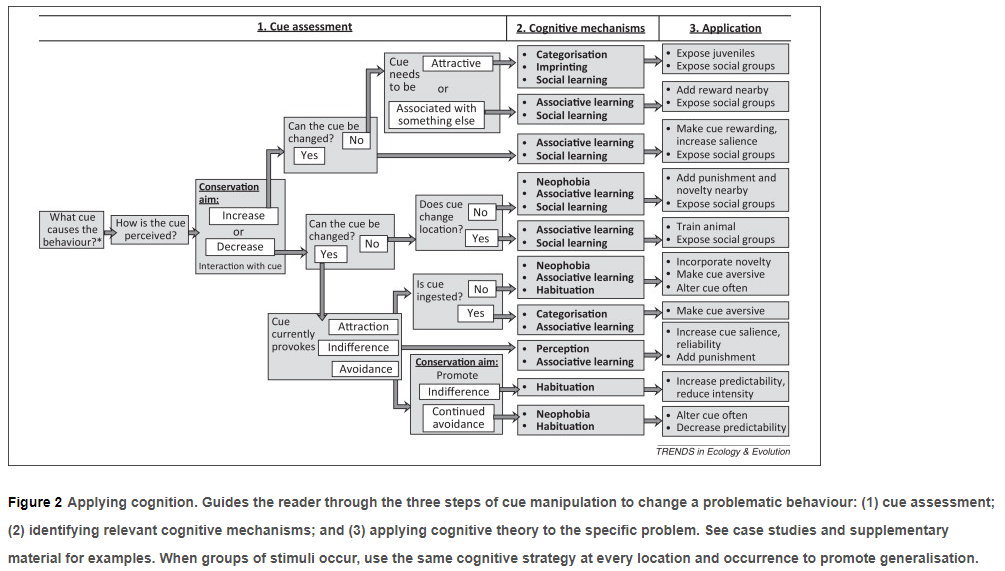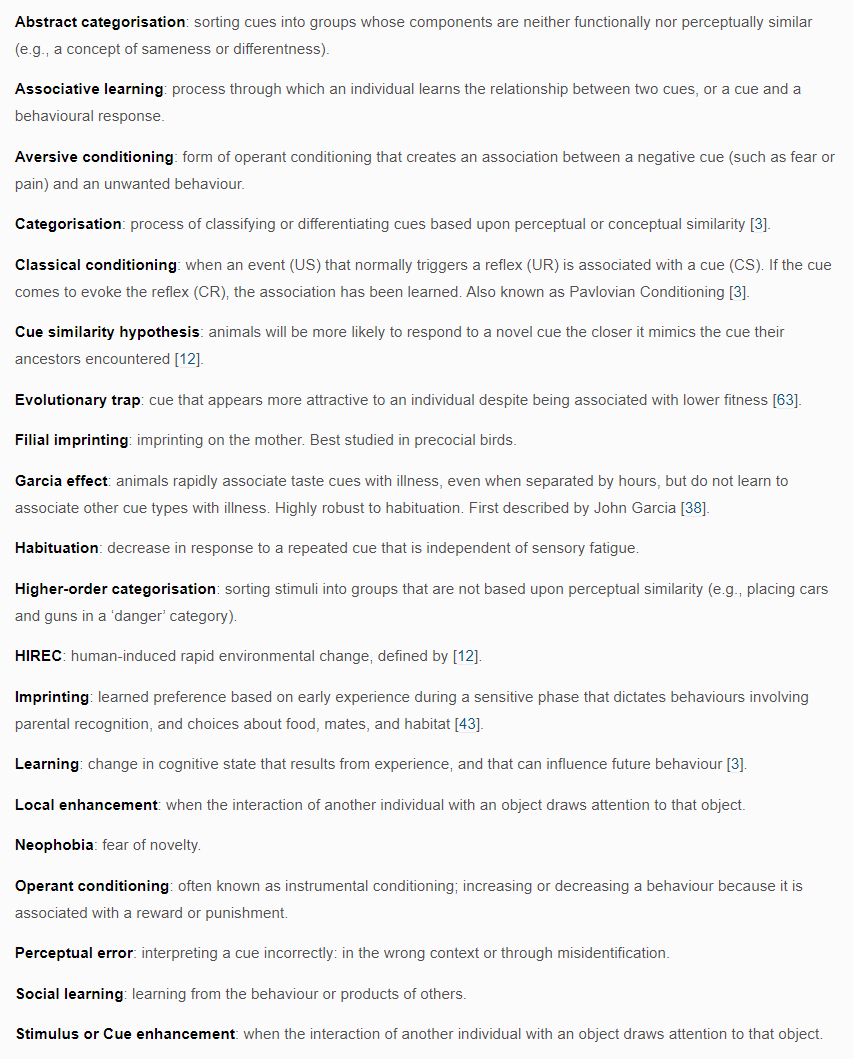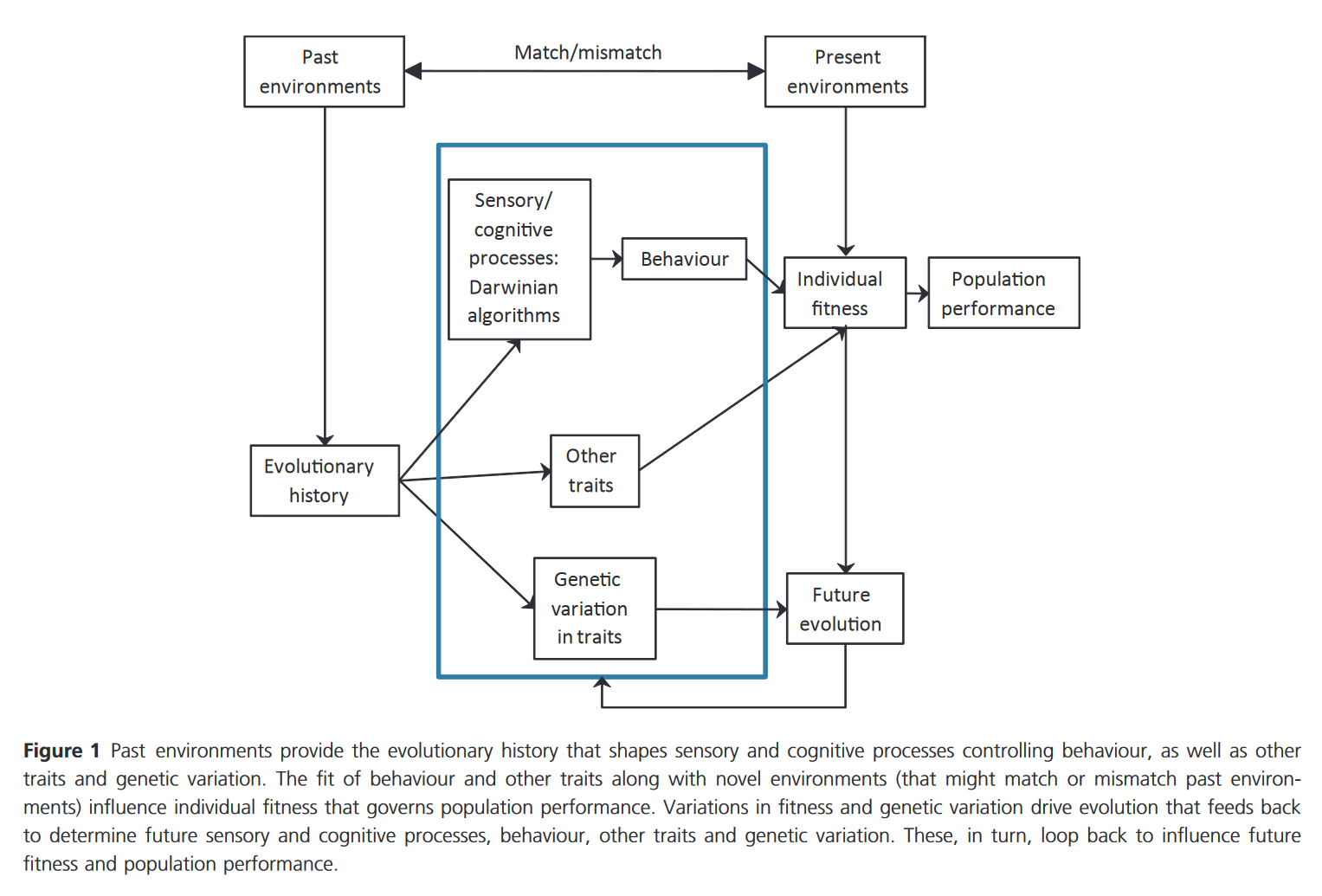Cognition
Cf.
4E Cognition
4E cognition (embodied, embedded, enactive, and extended) accepts that dynamic interactions between the brain, the body, the physical, and social environments together constitute cognition.
Bruin, Leon de, Albert Newen, and Shaun Gallagher, eds. The Oxford Handbook of 4E Cognition. Oxford: Oxford University Press, 2018.
Sepúlveda-Pedro, Miguel A. Enactive Cognition in Place: Sense-Making as the Development of Ecological Norms. Cham: Springer, 2023.
Varela, Francisco J., Evan Thompson, and Eleanor Rosch. The Embodied Mind: Cognitive Science and Human Experience. Revised. Cambridge, MA: MIT Press, 2016.
Cognition as Foundational to Evolution and Life
Shapiro, James Alan. Evolution: A View from the 21st Century. Fortified. 2nd ed. 2011. Reprint, Chicago: Cognition Press, 2022.
Turvey, Michael T. Lectures on Perception: An Ecological Perspective. New York: Routeldge, 2019.
Ecological Traps, Perception Traps, Opportunities, and Spaces of Negotiation
Ecological trap: looks good but is bad (typically for animals).
Perception trap: does not look attractive but is good to live in. E.g., animals avoid places with human presence, light, noise out of fear.
Novel ecosystems can create novel opportunities for animals to exploit new resources and habitats, but they can also create novel challenges such as ecological and perception traps.
Cf. phenotypic plasticity, behavioural plasticity.
All organisms live in unique perceptual worlds that are partial and subjective. The environmental change quickly under anthropogenic pressures, resulting in various misalignments with evolved capabilities, genetic, epigenetic, phenotypic plasticity, cognitive, behavioural, cultural.
To understand the dangers and options it is necessary to study comparative cognition and response to change. This is hard or impossible without observation and experimentation in the field. Design can support this experimentation.
Habitat Selection
Movement behaviours can be seen as a hierarchy such as:
- foraging (patch)
- dispersal (habitat)
- migration (landscape)
Habitat Selection, Oxford Bibliographies
Ways to Study Plant Habitat Selection
- observational studies. Measure plant abundance and environmental variables in different habitats. Using statistical models to identify the factors that influence plant distribution and preference. Observational studies can provide descriptive and correlative information about plant habitat selection, but cannot establish causal relationships or test hypotheses about the mechanisms of habitat selection. 1
- experimental studies. Manipulate one or more environmental variables in different habitats, and measure the response of plants in terms of growth, survival, reproduction, or dispersal. Experimental studies can provide causal and mechanistic information about plant habitat selection, but they may be limited by practical and ethical constraints, such as the availability of suitable sites, the feasibility of creating realistic treatments, and the potential impacts on natural ecosystems.
- theoretical studies. Develop mathematical models or simulations to explore the evolutionary and ecological consequences of different strategies of plant habitat selection, such as ideal pre-emptive versus passive dispersal. Theoretical studies can provide general and predictive information about plant habitat selection, but they may rely on simplifying assumptions or parameters that are difficult to measure or validate. 2
Ecological Traps in Plants
Ecological traps can occur in plants as well as animals. Ecological traps are scenarios in which rapid environmental change leads organisms to prefer to settle in poor-quality habitats. The idea is that organisms that selecting habitats rely on environmental cues to identify high-quality options. If the habitat quality or the cue changes so that one does not reliably indicate the other, organisms may be lured into poor-quality habitats.
Invasive plants can be an ecological trap if insects lay eggs on them even if they are of lower nutritional quality. Cf. trap cropping in gardening, a technique that involves introducing plants that attract pests away from the intended crop.
Some native plants may prefer to grow in open areas that have more light and moisture, but these areas may also be more prone to herbivory, fire, or drought. This can reduce the fitness and survival of the plants in these habitats.
Plants can actively select their habitats by dispersing their seeds, adjusting their growth, and communicating with other plants. These evolved to take a pattern of opportunities that might now be different or no longer exist.
- dispersing seeds. Wind, water, animals, sometimes long distances, as in coconuts. Hooks, hair (burdock), explosive seeds (witch hazel).
- adjusting growth. Modify their morphology, physiology, or behaviour to cope with stress or take advantage of opportunities. Change their leaf shape, size, or orientation to optimize photosynthesis and reduce water loss. Alter their root depth, density, or symbiosis to access more nutrients and water. Change their flowering time, colour, or scent to attract more pollinators. 3
- communication. Release volatile organic compounds (VOCs) that can affect the growth, development, or defence of nearby plants. Emit VOCs that warn other plants of herbivore attacks or disease infections, and induce them to produce more defensive compounds. Attract beneficial insects or microorganisms that can help them fight off pests or pathogens. Inhibit the germination or growth of competing plants, a phenomenon known as allelopathy.
References
Dyck, Hans Van. ‘Changing Organisms in Rapidly Changing Anthropogenic Landscapes: The Significance of the ‘Umwelt’-Concept and Functional Habitat for Animal Conservation’. Evolutionary Applications 5, no. 2 (2012): 144–53. https://doi.org/10/bn4dt9.
Sievers, Michael, Robin Hale, Kirsten M. Parris, and Stephen E. Swearer. ‘Impacts of Human-Induced Environmental Change in Wetlands on Aquatic Animals’. Biological Reviews 93, no. 1 (2018): 529–54. https://doi.org/10/gskrhc.
Maran, Timo. Ecosemiotics: The Study of Signs in Changing Ecologies. Cambridge: University of Cambridge, 2020.



Greggor, Alison L., Nicola S. Clayton, Ben Phalan, and Alex Thornton. ‘Comparative Cognition for Conservationists’. Trends in Ecology & Evolution 29, no. 9 (2014): 489–95. https://doi.org/10/f6hgdx.
Mescher, Mark C., and Consuelo M. De Moraes. ‘Role of Plant Sensory Perception in Plant–Animal Interactions’. Journal of Experimental Botany 66, no. 2 (2015): 425–33. https://doi.org/10/f66pc5.

Sih, Andrew, Maud C. O. Ferrari, and David J. Harris. ‘Evolution and Behavioural Responses to Human-Induced Rapid Environmental Change’. Evolutionary Applications 4, no. 2 (2011): 367–87. https://doi.org/10/c4vxnt.
Footnotes
McGarigal, Kevin, Ho Yi Wan, Kathy A. Zeller, Brad C. Timm, and Samuel A. Cushman. ‘Multi-Scale Habitat Selection Modeling: A Review and Outlook’. Landscape Ecology 31, no. 6 (2016): 1161–75. https://doi.org/10/f8wgrg.˄
Morris, Douglas W., Per Lundberg, and Joel S. Brown. ‘On Strategies of Plant Behaviour: Evolutionary Games of Habitat Selection, Defence, and Foraging’. Evolutionary Ecology Research, no. 17 (2016): 619–36.˄
Tie, Dan, Yuehan Guo, Chunrui Zhu, Jiaxin Quan, Shiqiang Liu, Zhe Zhou, Yongfu Chai, Ming Yue, and Xiao Liu. ‘Parental UV-B Radiation Regulates the Habitat Selection of Clonal’. Edited by Peter Bozhkov. Functional Plant Biology 49, no. 7 (2022): 600–612. https://doi.org/10/gskrjt.˄
Backlinks